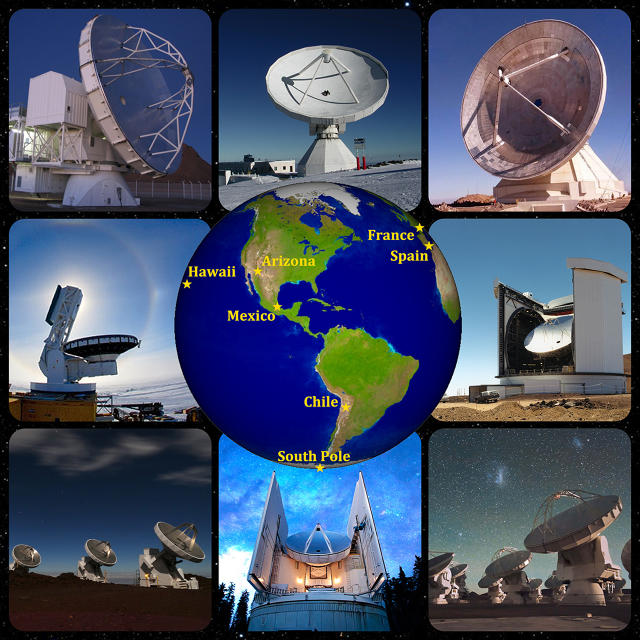Technical Ninjutsu And A Whole Lot Of Data: How To Photograph A Black Hole
Radio astronomer Shep Doeleman and the Event Horizon Telescope project are capturing humanity’s first images of black holes.
Shep Doeleman of the MIT Haystack Observatory has an unusual job: photographing the unseeable.
He works on the Event Horizon Telescope project, which uses ultra-powerful telescopes located at extremely high altitudes to form images of black holes. It’s one of the most cutting-edge scientific projects in the world, and one that requires more than aptitude for astronomy and math—it requires technological ninjutsu and a serious yen for project management.
The Event Horizon Telescope initiative, which began in 2008, uses nine telescopes around the world to help build “photographs” of the black hole, which is believed to lay at the center of the Milky Way galaxy. Doeleman, who is one of the project’s cofounders, says the goal is simple: “We replicate in radio waves what an optical dish does. An optical mirror’s perfect parabolic shape combines all the light hitting the mirror into a single focal point where you put the camera. In the technique we use, very-long-baseline interferometry (VLBI), different radio telescopes worldwide record data while looking at the same black hole at the same moment. We then compare data captured at different points around the globe in a super-computing cluster that essentially does the same job that the optical mirror does.”
When I spoke with Doeleman by Skype, he was working at the Mauna Kea Observatories, nearly 14,000 feet above sea level. By his standards, the experience at Mauna Kea was luxurious—”suffering in comfort,” as he put it. But Doeleman and his fellow astronomers often work under much more austere and difficult conditions.

Workflow At 15,000 Feet
Even with oxygen tanks, workers at 15,000 feet face significant challenges getting work done. Due to the nature of the work astronomers at facilities like the Atacama Pathfinder Experiment in Chile and Mauna Kea do, intense concentration is necessary.
“We systemize,” Doeleman told me. “There are lots of checklists. At base camp, when we’re at 9,000 feet, we write down our goals, what we’re doing, and what tasks are. Then we have a really good team. We have very knowledgeable experts who know what they’re supposed to do. There’s also supplementary oxygen at some sites like Chile, where we wear oxygen tanks, which helps a little bit.”
“And, importantly,” he added, “We do acclimatize. We don’t rush in and make mission-critical observations at the last moment. We get to a site a few days early, make trips up and down, and get used to the altitude. I personally have headaches the first three days. You give yourself time to get your altitude legs, so to speak. And after that, it’s mostly smooth sailing.”

The Tech Issues
Astronomers working on Event Horizon then face a unique challenge: Getting data from Point A to Point B. Because the black hole pictures are made by stitching data from separate telescopes together, they require storing massive amounts of data and then transporting the data from remote, inaccessible mountaintops to faraway cities.
At several sites, the Event Horizon team uses special extra-durable, helium-filled hard drives made by a manufacturer called HGST. The UltraStar Helioseal drives are designed for use in harsh environments and at high altitudes. Disks are then manually transported by couriers in a bulk carrying case from the telescope sites to a central facility at MIT where they are connected to an ultra-powerful server for analysis and repackaging.
“It’s a torrent of data. Our goal is 64 gigabits per second at each site,” Doeleman added. “In five days we record close to a petabyte of data at each site. It’s difficult, impossible really, to send petabytes over any network—the transfer rate of shipping hard disks back via airplane is much faster. Back at MIT, we correlate the data streams that were simultaneously recorded in Spain, Chile, Antarctica, and Hawaii. That replicates what an optical mirror does—what emerges from the correlator is a final data set equivalent to what a telescope as big as the Earth would see. With that magnifying power, we can make an image of a black hole.”

The Goal
The stakes are big for Doeleman and the rest of the Event Horizon team. By photographing the black hole, they hope to prove that black holes are not just theoretical, and that Albert Einstein’s and physicist Karl Schwarzschild’s predictions of their behavior are correct. If the team is wrong, Einstein’s theory of gravity will need serious revision.
And as Doeleman mock-seriously reminded me, “It’s a good idea not to bet against Einstein.”
At least once a year, the Event Horizon team from around the world converges for a general conference. This is where they compare observations, swap war stories, and talk about next steps. In the meantime, they connect via phone calls, emails, and Skype conversations to work closer toward photographing the black hole.
Wrapping up our conversation, Doeleman added, “This is delayed gratification for us. We’re in an anxious enterprise because you don’t know if these things are working until they all come together. To give an example, our photos from Chile were collected before the ones in Spain . . . everything combines at the focus.” On August 26 at 2 p.m. ET, Doeleman and colleagues from the Event Horizon project will hold an Ask Me Anything on Reddit to discuss their project.
And if the Event Horizon team plays their cards right, they may do what humanity has never done before in its history: capture images of a black hole.
Fast Company , Read Full Story
(116)














